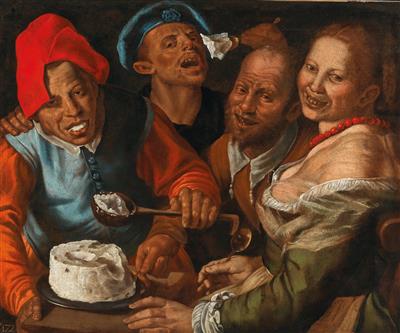School of Cremona, 16th Century

The Ricotta Eaters,
inscribed with an inventory number lower left: 172,
oil on canvas, 73 x 88 cm, framed
Exhibited:
Milan, Museo Diocesano, Gli occhi di Caravaggio: gli anni della formazione tra Venezia e Milano, ed. by V. Sgarbi, 11 March – 3 July 2011, pp. 102-103, cat. no. 2.8 (as Vincenzo Campi)
The present painting relates to a celebrated composition by Vincenzo Campi (Cremona 1536-1591) of which several versions are known. Each version is characterised by slight, yet significant differences. Two canvases are considered to be original prototypes: one is conserved in the Musèe des Beaux-Arts de Lyon (inv. no. H 673) and the other is in a private collection (see F. Paliaga, Vincenzo Campi: scene del quotidiano, Milan 2000, p. 27, fig. 7). The other known versions include the work in the Museo de Bellas Artes, Salamanca, on loan to the Museo del Prado (inv. no. 2715).
In contrast to the other versions, the present painting has a particular palette. The reds and blues of the figure to the left, as well as the green of the woman are singular. The colours can be compared with the palette used by Vincenzo Campi in the Fifteen Mysteries of the Rosary in the Collegiata church of San Bartolomeo, Busseto.
This painting represents three men and a woman, portrayed half length, gathered round a table and eating a large ricotta cheese. The whole composition communicates a merry atmosphere wherein the protagonists, country-folk, are described with accentuated gestures verging on the comic, as they take pleasure of consuming the cheese. This work exemplifies the realism typical of the pictorial style of Vincenzo Campi. The scene appears to be set in a tavern, and the comical, caricatural behaviour of the three villagers and the prosperously dressed maid appear provocative and irreverent.
This composition appears to contain allegorical meanings, possibly including the notion that female beauty, which fades rapidly, can be compared to the freshness of the delectable cheese. Therefore, the greed of the three villagers enjoying the ricotta could be read as an invitation to enjoy the carnal pleasures whilst it is possible. It has been suggested that the ricotta in the foreground may recall the form of a skull, thereby symbolically placing a memento mori in an atmosphere characterised by abandon and excess.
Esperto: Mark MacDonnell
 Mark MacDonnell
Mark MacDonnell
+43 1 515 60 403
old.masters@dorotheum.com
10.11.2020 - 16:00
- Prezzo realizzato: **
-
EUR 25.700,-
- Stima:
-
EUR 20.000,- a EUR 30.000,-
School of Cremona, 16th Century
The Ricotta Eaters,
inscribed with an inventory number lower left: 172,
oil on canvas, 73 x 88 cm, framed
Exhibited:
Milan, Museo Diocesano, Gli occhi di Caravaggio: gli anni della formazione tra Venezia e Milano, ed. by V. Sgarbi, 11 March – 3 July 2011, pp. 102-103, cat. no. 2.8 (as Vincenzo Campi)
The present painting relates to a celebrated composition by Vincenzo Campi (Cremona 1536-1591) of which several versions are known. Each version is characterised by slight, yet significant differences. Two canvases are considered to be original prototypes: one is conserved in the Musèe des Beaux-Arts de Lyon (inv. no. H 673) and the other is in a private collection (see F. Paliaga, Vincenzo Campi: scene del quotidiano, Milan 2000, p. 27, fig. 7). The other known versions include the work in the Museo de Bellas Artes, Salamanca, on loan to the Museo del Prado (inv. no. 2715).
In contrast to the other versions, the present painting has a particular palette. The reds and blues of the figure to the left, as well as the green of the woman are singular. The colours can be compared with the palette used by Vincenzo Campi in the Fifteen Mysteries of the Rosary in the Collegiata church of San Bartolomeo, Busseto.
This painting represents three men and a woman, portrayed half length, gathered round a table and eating a large ricotta cheese. The whole composition communicates a merry atmosphere wherein the protagonists, country-folk, are described with accentuated gestures verging on the comic, as they take pleasure of consuming the cheese. This work exemplifies the realism typical of the pictorial style of Vincenzo Campi. The scene appears to be set in a tavern, and the comical, caricatural behaviour of the three villagers and the prosperously dressed maid appear provocative and irreverent.
This composition appears to contain allegorical meanings, possibly including the notion that female beauty, which fades rapidly, can be compared to the freshness of the delectable cheese. Therefore, the greed of the three villagers enjoying the ricotta could be read as an invitation to enjoy the carnal pleasures whilst it is possible. It has been suggested that the ricotta in the foreground may recall the form of a skull, thereby symbolically placing a memento mori in an atmosphere characterised by abandon and excess.
Esperto: Mark MacDonnell
 Mark MacDonnell
Mark MacDonnell
+43 1 515 60 403
old.masters@dorotheum.com
|
Hotline dell'acquirente
lun-ven: 10.00 - 17.00
old.masters@dorotheum.at +43 1 515 60 403 |
| Asta: | Dipinti antichi |
| Tipo d'asta: | Asta in sala con Live Bidding |
| Data: | 10.11.2020 - 16:00 |
| Luogo dell'asta: | Wien | Palais Dorotheum |
| Esposizione: | 04.11. - 10.11.2020 |
** Prezzo d’acquisto comprensivo dei diritti d’asta acquirente e IVA
Non è più possibile effettuare un ordine di acquisto su Internet. L'asta è in preparazione o è già stata eseguita.
